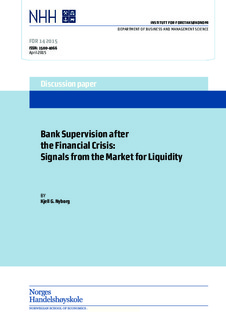| dc.description.abstract | The financial turmoil that we have been living with since August 2007 has left central
banks, regulators, politicians, and economists with two big, overriding questions: How do
we best get out of the crisis and how should banks be regulated and markets organized to
avoid such crises in the future. This paper deals with the second question. Specifically,
the paper deals with the third pillar of Bank supervision under Basel II, namely market
discipline. The idea of this pillar, as summarized by Emmons, Gilbert, and Vaughan
(2001), is for supervisors and regulators to make use of information about the financial
health of banks that is contained in securities prices. In particular, as explained by
Emmons et al: “The recent market discipline discussion centers on proposals to require
some banks to issue a standardized form of subordinated debt.” Flannery (1998)
discusses this more broadly and reviews the evidence on the effectiveness of using
market information in prudential supervision. My proposal here is that the market
discipline approach could usefully look for information about banks’ financial health
outside of the securities markets. | nb_NO |
